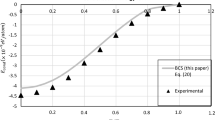Abstract
Using the generalized DMFT+Σ approach, we study the influence of disorder on single-particle properties of the normal phase and the superconducting transition temperature in the attractive Hubbard model. A wide range of attractive potentials U is studied, from the weak coupling region, where both the instability of the normal phase and superconductivity are well described by the BCS model, to the strong-coupling region, where the superconducting transition is due to Bose-Einstein condensation (BEC) of compact Cooper pairs, formed at temperatures much higher than the superconducting transition temperature. We study two typical models of the conduction band with semi-elliptic and flat densities of states, respectively appropriate for three-dimensional and two-dimensional systems. For the semi-elliptic density of states, the disorder influence on all single-particle properties (e.g., density of states) is universal for an arbitrary strength of electronic correlations and disorder and is due to only the general disorder widening of the conduction band. In the case of a flat density of states, universality is absent in the general case, but still the disorder influence is mainly due to band widening, and the universal behavior is restored for large enough disorder. Using the combination of DMFT+Σ and Nozieres-Schmitt-Rink approximations, we study the disorder influence on the superconducting transition temperature T c for a range of characteristic values of U and disorder, including the BCS-BEC crossover region and the limit of strong-coupling. Disorder can either suppress T c (in the weak-coupling region) or significantly increase T c (in the strong-coupling region). However, in all cases, the generalized Anderson theorem is valid and all changes of the superconducting critical temperature are essentially due to only the general disorder widening of the conduction band.
Similar content being viewed by others
References
D. M. Eagles, Phys. Rev. 186, 456 (1969).
A. J. Leggett, in: Modern Trends in the Theory of Condensed Matter, Ed. by A. Pekalski and J. Przystawa (Springer-Verlag, Berlin, 1980).
P. Nozieres and S. Schmitt-Rink, J. Low Temp. Phys. 59, 195 (1985).
I. Bloch, J. Dalibard, and W. Zwerger, Rev. Mod. Phys. 80, 885 (2008).
L. P. Pitaevskii, Phys.—Usp. 49(4), 333 (2006).
Th. Pruschke, M. Jarrell, and J. K. Freericks, Adv. Phys. 44, 187 (1995).
A. Georges, G. Kotliar, W. Krauth, and M. J. Rozenberg, Rev. Mod. Phys. 68, 13 (1996).
D. Vollhardt, in Lectures on the Physics of Strongly Correlated Systems XIV, Ed. by A. Avella and F. Mancini (American Institute of Physics, Melville, New York, 2010), AIP Conf. Proc. 1297, 339; D. Vollhardt, arXiv:1004.5069.
M. Keller, W. Metzner, and U. Schollwock, Phys. Rev. Lett. 86, 4612 (2001); M. Keller, W. Metzner, and U. Schollwock, arXiv:cond-mat/0101047.
A. Toschi, P. Barone, M. Capone, and C. Castellani, New J. Phys. 7, 7 (2005); A. Toschi, P. Barone, M. Capone, and C. Castellani, arXiv:cond-mat/0411637v1.
J. Bauer, A. C. Hewson, and N. Dupis, Phys. Rev. B: Condens. Matter 79, 214518 (2009); J. Bauer, A. C. Hewson, and N. Dupis, arXiv:0901.1760v2.
A. Koga and P. Werner, Phys. Rev. A: At., Mol., Opt. Phys. 84, 023638 (2011); A. Koga and P. Werner, arXiv:1106.4559v1.
N. A. Kuleeva, E. Z. Kuchinskii, and M. V. Sadovskii, J. Exp. Theor. Phys. 119(2), 264 (2014); N. A. Kuleeva, E. Z. Kuchinskii, and M. V. Sadovskii, arXiv:1401.2295.
A. I. Posazhennikova and M. V. Sadovskii, JETP Lett. 65(3), 270 (1997).
F. Palestini and G. C. Strinati, Phys. Rev. B: Condens. Matter 88, 174504 (2013); F. Palestini and G. C. Strinati, arXiv:1311.2761.
E. Z. Kuchinskii, I. A. Nekrasov, and M. V. Sadovskii, JETP Lett. 82(4), 198 (2005); E. Z. Kuchinskii, I. A. Nekrasov, and M. V. Sadovskii, arXiv:cond-mat/0506215.
M. V. Sadovskii, I. A. Nekrasov, E. Z. Kuchinskii, Th. Prushke, and V. I. Anisimov, Phys. Rev. B: Condens. Matter 72, 155105 (2005); M. V. Sadovskii, I. A. Nekrasov, E. Z. Kuchinskii, Th. Prushke, and V. I. Anisimov, arXiv:cond-mat/0508585.
E. Z. Kuchinskii, I. A. Nekrasov, and M. V. Sadovskii, Low Temp. Phys. 32(4), 398 (2006); E. Z. Kuchinskii, I. A. Nekrasov, and M. V. Sadovskii, arXiv:condmat/0510376.
E. Z. Kuchinskii, I. A. Nekrasov, and M. V. Sadovskii, Phys.—Usp. 55(4), 325 (2012); E. Z. Kuchinskii, I. A. Nekrasov, and M. V. Sadovskii, arXiv:1109.2305.
E. Z. Kuchinskii, I. A. Nekrasov, and M. V. Sadovskii, J. Exp. Theor. Phys. 106(3), 581 (2008); E. Z. Kuchinskii, I. A. Nekrasov, and M. V. Sadovskii, arXiv:0706.2618.
E. Z. Kuchinskii, N. A. Kuleeva, I. A. Nekrasov, and M. V. Sadovskii, J. Exp. Theor. Phys. 110(2), 325 (2010); E. Z. Kuchinskii, N. A. Kuleeva, I. A. Nekrasov, and M. V. Sadovskii, arXiv:0908.3747.
E. Z. Kuchinskii, I. A. Nekrasov, and M. V. Sadovskii, Phys. Rev. B: Condens. Matter 80, 115124 (2009); E. Z. Kuchinskii, I. A. Nekrasov, and M. V. Sadovskii, arXiv:0906.3865.
E. Z. Kuchinskii, I. A. Nekrasov, and M. V. Sadovskii, Phys. Rev. B: Condens. Matter 75, 115102 (2007); E. Z. Kuchinskii, I. A. Nekrasov, and M. V. Sadovskii, arXiv:cond-mat/0609404.
E. Z. Kuchinskii, N. A. Kuleeva, and M. V. Sadovskii, JETP Lett. 100(3), 192 (2014); E. Z. Kuchinskii, N. A. Kuleeva, and M. V. Sadovskii, arXiv:1406.5603.
A. A. Abrikosov, L. P. Gor’kov, and I. E. Dzyaloshinskii, Quantum Field Theoretical Methods in Statistical Physics (Pergamon, Oxford, 1965); M. V. Sadovskii, Diagrammatics (World Scientific, Singapore, 2006).
R. Bulla, T. A. Costi, and T. Pruschke, Rev. Mod. Phys. 60, 395 (2008).
M. V. Sadovskii, Superconductivity and Localization (World Scientific, Singapore, 2000).
P. G. De Gennes, Superconductivity of Metals and Alloys (W. A. Benjamin, New York, 1966).
Author information
Authors and Affiliations
Corresponding author
Additional information
The article is published in the original.
Rights and permissions
About this article
Cite this article
Kuchinskii, E.Z., Kuleeva, N.A. & Sadovskii, M.V. Attractive Hubbard model with disorder and the generalized Anderson theorem. J. Exp. Theor. Phys. 120, 1055–1063 (2015). https://doi.org/10.1134/S1063776115050143
Received:
Published:
Issue Date:
DOI: https://doi.org/10.1134/S1063776115050143




